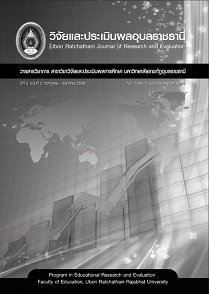An Action of Physics Problem Solving Development on Force and Law Motion Theory Through the 7E Inquiry Learning Process for Mathayom Suksa 4 Students Krachaengwittaya School under the Jurisdiction of Secondary Educational Service Area Office 28
Keywords:
การวิจัยปฏิบัติการ, กระบวนการจัดการเรียนรู้แบบสืบเสาะหาความรู้ 7E, การแก้โจทย์ปัญหาAbstract
The purposes of this research were 1) to operate an action research on the development of students’ ability in physics problem solving on force and law motion theory using the 7E Inquiring learning process, and 2) to determine the result of the development of students’ ability in physics problem solving. The samples of the study were 35 Matthayom Suksa 4 students selected by purposive sampling. The instrument were: 1) seven lesson plans using the 7E inquiring learning process, 2) a test on physics problem solving, 3) an observation form, 4) an interview form, and 5) a diary. The action research had three circles. The statistical procedures used were percentage, mean, and standard deviation.
The research findings were as follows:
- The action on the development of physics problem solving on force and law motion theory using 7E inquiring learning process had seven steps: 1) elicitation of prior knowledge, 2) engagement, 3) exploration, 4) explanation, 5) expansion, 6) evaluation, and 7 extension. The action on the development of the students in physics on force and law motion theory had seven lesson plans and three circles, enabling the students to have abilities in physics problem solving, namely:
1) understanding-exploring of problems, 2) analyzing, 3) finding relations, 4) finding answers, and
5) checking answers. - The result of the action research on the development using 7E inquiring learning process showed that the students had the average score of 78.68% Not less than 80% of the students was able to solve the problems by passing the set criterion of 70%.
References
นันทิยา บุญเคลือบ. “การเรียนการสอนวิทยาสาสตร์ตามแนวคิด Constructivism,” วารสาร สสวท.
25,96 (มกราคม-มีนาคม 2540): 13-14 .
ภักคีณี จีนามูล. ผลการสอนแบบ 7E ที่มีต่อผลสัมฤทธิ์ทางการเรียนวิชาฟิสิกส์และความสามารถในการแก้ปัญหา ทางวิทยาศาสตร์ของนักเรียนชั้นมัธยมศึกษาปีที่ 4 โรงเรียนเทศบาลเมืองสวรรคโลก จังหวัดสุโขทัย. วิทยานิพนธ์ศึกษาศาสตรมหาบัณฑิต มหาวิทยาลัยสุโขทัยธรรมมาธิราช, 2555.
ลักษณา ศิริมาลา. ความสามารถในการแก้ปัญหาและผลสัมฤทธิ์ทางการเรียนวิทยาศาสตร์ของนักเรียนชั้นมัธยมศึกษาปีที่ 1 ที่เรียนโดยใช้รูปแบบการเรียนการสอน 7E. วิทยานิพนธ์ศึกษาศาสตรมหาบัณฑิต มหาวิทยาลัยขอนแก่น, 2553.
วิชาการ, กรม. หลักสูตรการศึกษาขั้นพื้นฐาน พุทธศักราช 2544. กรุงเทพฯ: องค์การรับส่งสินค้าและพัสดุภัณฑ์, 2545.
วิดาด หะยีตาเฮร์. ผลของรูปแบบการเรียนการสอนแบบวัฏจักรการเรียนรู้ 7 ขั้น (7E) ต่อผลสัมฤทธิ์ทางการเรียน ความสามารถในการแก้ปัญหาและเจตคติต่อการเรียนวิชาเคมีของนักเรียนชั้นมัธยมศึกษาปีที่4
ในสังคมพหุวัฒนธรรม. วิทยานิพนธ์ศึกษาศาสตรมหาบัณฑิต มหาวิทยาลัยสงขลานครินทร์, 2557.
ศุภชัย ดวงคำน้อย. การศึกษาความสามารถในการแก้ปัญหาและผลสัมฤทธิ์ทางการเรียนวิชาฟิสิกส์ เรื่อง แสง โดยใช้รูปแบบการสอนแบบวัฏจักรการเรียนรู้ 7 ขั้นสำหรับนักเรียนชั้นมัธยมศึกษาปีที่ 5. วิทยานิพนธ์ศึกษาศาสตรมหาบัณฑิต มหาวิทยาลัยขอนแก่น, 2555.
สุวัฒน์ นิยมค้า. ทฤษฎีและทางปฏิบัติ : ในการสอนวิทยาศาสตร์แบบสืบเสาะหาความรู้. กรุงเทพฯ:
เจเนอรัลบุ๊คเซนเตอร์, 2531.
อมราลักษณ์ ฤทธิเดช. ความสามารถในการแก้โจทย์ปัญหาวิชาฟิสิกส์ของนักเรียนชั้นมัธยมศึกษาปีที่ 4 ที่สอนโดยใช้กลวิธีแก้ปัญหาเชิงตรรกะของเฮลเลอร์และเฮลเลอร์. วิทยานิพนธ์ศึกษาศาสตรมหาบัณฑิต มหาวิทยาลัยเชียงใหม่, 2553.
Eisenkraft, Arthur. “Expanding the 5-E Model : A Proposed 7-E Model Emphasizes Transfer of Learning and the Importance of Eliciting Prior Understanding,” The Science Teacher.
70,6 (September 2003): 57-59.
Downloads
Published
How to Cite
Issue
Section
License
1. บทความที่ตีพิมพ์ในวารสารนี้ได้มีการตรวจสอบการลอกเลียนงานวรรณกรรมแล้ว ไม่เกินร้อยละ 25
2. บทความที่ตีพิมพ์ในวารสารนี้เป็นข้อคิดเห็น ข้อค้นพบของผู้เขียนบทความ โดยผู้เขียนบทความต้องเป็นผู้รับผิดชอบต่อผลทางกฎหมายใด ๆ ที่อาจเกิดขึ้นจากบทความนั้น ๆ
3. บทความ ข้อมูล เนื้อหา รูปภาพ ฯลฯ ที่ได้รับการตีพิมพ์ในวารสารวิจัยและประเมินผลอุบลราชธานี ถือเป็นลิขสิทธิ์ของวารสารวิจัยและประเมินผลอุบลราชธานี หากบุคคลหรือหน่วยงานใดต้องการนำทั้งหมดไปเผยแพร่ต่อหรือเพื่อกระทำการใดๆ จะต้องได้รับอนุญาตเป็นลายลักษณ์อักษรจากวารสารวิจัยและประเมินผลอุบลราชธานีก่อนเท่านั้น และจะต้องมีการอ้างอิงวารสารวิจัยและประเมินผลอุบลราชธานี ฉบับนั้น ๆ ด้วย






